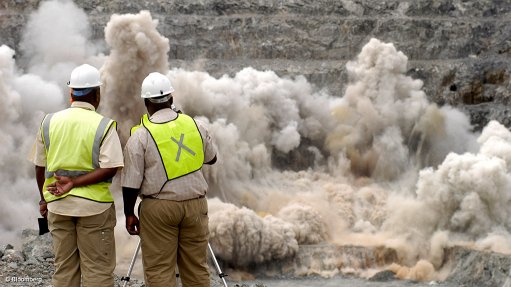
CAUTION NEEDED The potential for postblast fume problems has to be taken into consideration at managerial level so that clear direction on fume minimisation can be provided to all staff
Photo by: Bloomberg
Mines should try to create conditions that reduce the risk of toxic-fume production during blasting, says business consulting service company Kilmorie Consulting.
The company notes that, in most cases, fumes emanating from the use of explosives are nontoxic; however, an understanding of the conditions and explosives types that are more likely to produce fumes, is necessary.
Blasts should then be designed with these factors in mind, states Kilmorie Consulting director Alastair Torrance, adding that the potential for postblast fume problems has to be taken into consideration at a managerial level so that clear direction on fume minimisation can be provided to all staff.
Torrance was a speaker at explosives supply chain company BME’s twenty- third yearly drilling and blasting conference in November at the Council for Scientific and Industrial Research, in Pretoria.
He further notes that it also helps to design blasts bearing in mind that fumes will need to be dealt with, as opposed to only concentrating on the fragmentation and movement of the rock and ground surface.
Torrance says changing rock strata also needs to be taken into consideration, particularly the presence and influence of water in a blasthole and across a shot.
Postblast fume events are typically associated with nonstandard conditions, such as water-saturated strata, soft rocks and deep, confined blasts and thereby particular care needs to be taken with explosives selection in these conditions.
The performance of commercial explosives is influenced by the conditions under which they are used and, therefore, measurements produced using laboratory techniques do not always accurately reflect the quality and performance of the product in the field.
The techniques used as quality-control checks in the field tend to be more reflective of the expected density rather than the actual in-hole densities for blended emulsion products.
Blast measurements, including velocity of detonation, provide insight into the performance of explosives in soft ground and can also indicate that the blast outcome may not be what is expected if solely relying on published technical information.
Further, Torrance tells Mining Weekly that every effort must be taken to blast in a safe manner. The mine must consider the geology, water content of the ground and the type of explosive to be used to design a safe and efficient blast.
“Ultimately, you also need to have a management plan in place so that, should excessive toxic fumes be produced, all personnel can be moved to a safe place,” he advises.
E
xposure to, for instance, nitrogen oxide fumes is potentially serious, with health guidelines available on the chemical, such as the Queensland Guidance Note 20 on the management of oxides of nitrogen in opencut blasting, which contains information about the occupational exposure standards and health effects of nitrogen dioxide.
Meanwhile, Torrance says Kilmorie Consulting can provide training regarding the safe and efficient use of explosives in opencut mining and, on request, more detailed training regarding the chemistry of explosives and detonics.
“In the area of fumes, specifically, Kilmorie Consulting works with mines to put in place strategies to reduce the potential of postblast fume production,” he says.